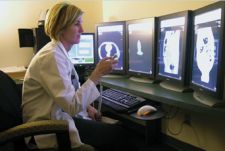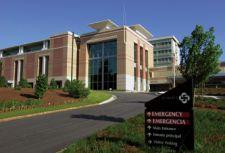
Dr. Gerety, a radiologist at St. Mary's Hospital, is sitting at the AMICAS PACS workstation.
“St. Mary’s wanted to maximize productivity in the radiology suite – and beyond – while leveraging the investment we had already made in our MEDITECH HIS,” said Lyn Wilkinson, director of Radiology at St. Mary’s Hospital in Athens, GA. “We wanted to ensure that our PACS would have tight integration with MEDITECH to enable radiologists, referring physicians and technologists to use their time efficiently.”
The key to addressing St. Mary’s initial workflow challenges was finding a PACS partner that met the following requirements: a strong history of MEDITECH integrations, the know-how to meet their immediate workflow needs at go-live and the willingness to listen to their feedback and make improvements over time.
Servicing Referring Physicians
At St. Mary’s, a 200-bed facility performing about 85,000 imaging procedures per year, most of the referring doctors used MEDITECH’s EMR as the central repository for patients’ vital information. Within this application, physicians could view patient visits, lab results and diagnostic reports.
The only missing piece was the ability to review patients’ radiology images. Brian Duncan and Page Meadow, PACS Administrators at St. Mary’s, knew that a successful PACS deployment would have to integrate seamlessly with MEDITECH’s EMR.
With their Web-based PACS from AMICAS, St. Mary’s neither has to transport cumbersome film-based studies to and from the film library, nor do they have to spend time faxing reports to referring physicians. At go-live, both in-house radiologists and referring physicians had convenient and secure access to patients’ current and prior studies within MEDITECH’s EMR, an application they used every day.
“Ninety-five percent of our doctors view images through MEDITECH’s EMR, and that is where they want to spend most of their time,” said Duncan. St. Mary’s PACS solution now saves time and money for physicians and patients by providing easy access to images.
“As the first hospital in our area with a fully integrated EMR, St. Mary’s can minimize the challenges typically associated with integrating these types of systems. We can focus on what is most important: providing excellent care to our patients,” added Wilkinson.
Easy System Maintenance and Reporting
Duncan knew that the day-to-day chaos of their radiology department would not allow much time for routine system maintenance and reporting. St. Mary’s needed a solution that could easily report on key metrics from their radiology department and not require a lot of in-house resources to maintain and support.
Enter AMICAS’ Vision Watch, which proactively monitors hundreds of system performance parameters, automatically alerting Duncan and Meadow if a problem occurs. This low-maintenance monitoring frees up Duncan and Meadow from constantly checking the system and allows them to deal with issues before end users notice them. Vision Watch offers an easy way for radiology staff to gain important information about their department (such as exam volume by referring physicians), without requiring “report writer” technical knowledge.
“With Vision Watch, email alerts are sent to my pager and email if there are system problems,” said Duncan. “And the reporting functionality in Vision Watch helps us proactively manage our department with information that is traditionally difficult to access.”
Ongoing Innovation Solves Workflow Bottlenecks
A workflow bottleneck that Duncan and Meadow identified – after go-live – was the time technologists were spending manually entering patient information from their MEDITECH Client/Server system into PACS.
“We had been live on PACS for a few years and realized that technologists were spending about 20 percent of their time reading information in MEDITECH and then typing that information into PACS,” said Meadow.
This was not simple demographic and order information, which had already been automated through the AMICAS/MEDITECH interface – rather, it was detailed clinical information (i.e. smoking history, pregnancy and the presence of metallic implants) that was captured in MEDITECH’s Customer Defined Screens (CDS).
This clinical history is crucial to St. Mary’s radiologists when they perform their primary interpretations on every exam they view. When radiologists do not receive this information digitally, they either have to rely on paper forms or log in to a separate system.
Advanced Clinicals Exchange, a new feature of their AMICAS PACS, shares clinical data included in MEDITECH’s CDS questionnaires with their PACS. This innovative feature eliminates the need for technologists to transpose this information from one application to another.
Tighter integration means better workflow because now radiologists have the data they need in one centralized place. They no longer need to leave the PACS workstation to search for other information.
“We could not operate as efficiently as we do without this ongoing innovation – innovation that is on target for the challenges we face in our hospital,” said Meadow. “With the introduction of Advanced Clinicals Exchange, we can focus on what we do best. Our technologists are not spending time typing information from one system to another, and our radiologists have all the information they need in one place.”


